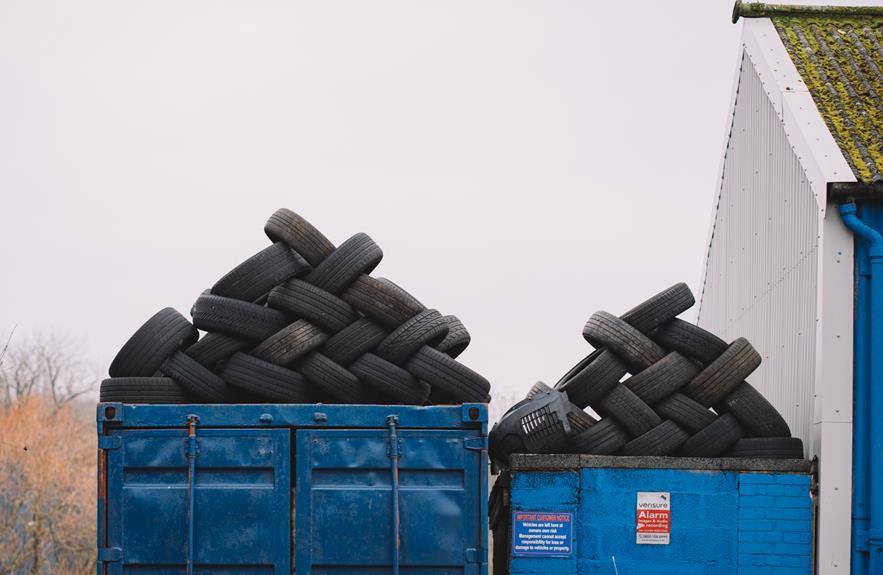Tire Recycling Programs: Going Beyond Disposal
Tire recycling programs are the driving force behind a sustainable solution for waste management, going beyond mere disposal.
Like a well-oiled machine, these programs are revolutionizing the environmental impact of tire waste, repurposing old tires through innovative approaches.
With creative applications and the economic growth and job creation they bring, tire recycling is a key player in the quest for a greener future.
By harnessing the power of technology, overcoming challenges, and fostering collaboration, these programs are paving the way for advancements and opportunities in tire recycling.
Key Takeaways
- Tire recycling programs minimize the environmental impact of tire disposal and maximize the reuse and recycling of tire materials.
- Innovative approaches such as tire upcycling and repurposing find unique applications for old tires, reducing the demand for new materials.
- Tire-derived products and technologies, such as playground surfaces and fashion accessories, promote waste reduction and resource conservation.
- Tire recycling programs offer various benefits, including reducing reliance on fossil fuels, providing cost-effective solutions for construction, and promoting sustainable practices in the industry.
Tire Recycling: A Sustainable Solution for Waste Management
The tire recycling industry's sustainable practices have proven to be an effective solution for waste management. With the increasing concern for environmental sustainability, sustainable tire management has gained significant attention. This approach aims to minimize the environmental impact of tire disposal and maximize the reuse and recycling of tire materials.
The circular economy approach forms the foundation of sustainable tire management. Instead of treating tires as waste, this approach views them as valuable resources that can be reused or recycled. One of the key strategies in sustainable tire management is tire retreading, which involves replacing the worn-out tread of a tire with a new one. This process not only extends the lifespan of the tire but also reduces the demand for new tires, conserving valuable resources.
Additionally, tire recycling facilities employ advanced technologies to break down used tires into their constituent materials, such as rubber, steel, and fibers. These materials can then be utilized in various industries, including construction, automotive, and manufacturing. By closing the loop and reintegrating tire materials into the production cycle, the circular economy approach minimizes waste generation and promotes resource conservation.
The Environmental Impact of Tire Waste
One potential solution to mitigate the environmental impact of tire waste is through implementing stricter regulations and promoting sustainable alternatives. The improper disposal of tires has detrimental effects on the environment, including soil and water pollution, as well as the release of harmful chemicals into the air. To address this issue, here are some key steps that can be taken:
- Enforcing tire recycling laws: Stricter regulations can be put in place to ensure that tire manufacturers and retailers are responsible for properly disposing of used tires. This can include penalties for non-compliance and regular inspections to monitor adherence to recycling guidelines.
- Investing in tire recycling facilities: By establishing more tire recycling facilities, we can create a sustainable solution for tire waste management. These facilities can process used tires into valuable resources such as fuel, rubber powder, and steel, reducing the need for landfill disposal and minimizing environmental impact.
- Promoting the use of recycled tire products: Encouraging the use of recycled tire products, such as rubberized asphalt for road construction or rubber mulch for landscaping, not only helps reduce tire waste but also provides economic benefits. These products are cost-effective and durable, offering long-term environmental and economic solutions.
- Raising public awareness: Educating the public about the environmental consequences of tire waste and the importance of proper disposal can help change attitudes and behaviors. This can be done through educational campaigns, community outreach programs, and partnerships with local organizations.
Repurposing Old Tires: Innovative Approaches
Repurposing old tires is becoming increasingly important as we seek innovative approaches to address the issue of tire waste.
Creative tire upcycling involves transforming old tires into new and useful products, such as furniture, playground equipment, and even fashion accessories.
Sustainable tire repurposing focuses on using old tires in construction projects, road surfaces, and as alternative fuel sources.
Lastly, innovative tire reuse involves finding new and unique applications for old tires, such as using them in eco-friendly art installations or as materials for building sustainable homes.
Creative Tire Upcycling
How can we creatively upcycle old tires to reduce waste and promote sustainability?
Upcycling old tires not only helps reduce waste but also promotes sustainability by giving new life to materials that would otherwise end up in landfills. Here are some creative ways to upcycle old tires:
- Upcycled tire furniture: Old tires can be transformed into unique and stylish furniture pieces such as chairs, tables, and ottomans. By repurposing tires, we can create functional and aesthetically pleasing furniture while reducing the demand for new materials.
- Artistic tire sculptures: Skilled artists can turn old tires into stunning sculptures, showcasing their creativity and talent. These sculptures can be used as decorative pieces in public spaces, gardens, or even as art installations.
- Tire planters: By cutting a tire in half and adding soil, old tires can be transformed into planters for growing flowers, herbs, or even small vegetables. This not only adds greenery to our surroundings but also reduces the need for traditional plastic or clay planters.
- Tire playgrounds: Old tires can be repurposed to create fun and interactive playground equipment for children. Tire swings, climbing structures, and obstacle courses can be built using discarded tires, providing a safe and enjoyable play experience while reducing waste.
Sustainable Tire Repurposing
In the realm of sustainable tire repurposing, organizations are exploring innovative approaches to not only reduce waste but also create valuable products from discarded tires.
As the demand for sustainable tire manufacturing grows, circular economy initiatives are gaining momentum. These initiatives aim to close the loop by keeping resources in use for as long as possible and maximizing their value.
One such approach is the development of new technologies that can break down used tires into their basic components, such as rubber and steel, which can then be reused in various applications.
Additionally, innovative tire reuse methods are being explored, including the creation of playground surfaces, construction materials, and even fashion accessories.
These efforts not only contribute to waste reduction but also promote a more sustainable and environmentally friendly approach to tire disposal.
Innovative Tire Reuse
A significant number of organizations are exploring innovative tire reuse techniques and, as a result, finding new ways to repurpose old tires. This growing focus on tire reuse is driven by the increasing need for sustainable alternatives to traditional disposal methods.
Some of the reuse ideas being explored include:
- Tire-derived fuel: Old tires can be burned as a fuel source in cement kilns or power plants, reducing the reliance on fossil fuels.
- Tire-derived aggregate: Ground-up tires can be used as a substitute for traditional construction materials, such as gravel or sand, in various applications like road construction and building foundations.
- Tire-derived rubber products: Old tires can be processed to create new rubber-based products, such as playground surfaces, athletic tracks, and rubber mulch for landscaping.
- Tire recycling technologies: Advanced recycling technologies are being developed to break down tires into their component materials, such as steel, rubber, and fibers, which can be used in various manufacturing processes.
These innovative tire reuse techniques offer sustainable alternatives to traditional disposal methods, reducing waste and promoting a circular economy.
In the subsequent section, we will explore the creative applications of reusing old tires.
Reusing Old Tires: Creative Applications
One effective way to address the issue of tire waste is by exploring the many innovative applications that can be achieved through reusing old tires. By finding creative ways to repurpose tires, we can not only reduce waste but also create functional and aesthetically pleasing products. Two popular examples of this are upcycled tire furniture and tire art installations.
Upcycled tire furniture involves transforming old tires into unique and stylish pieces of furniture. These can include chairs, tables, and even ottomans. The durability of tires makes them an ideal material for furniture that can withstand both indoor and outdoor use. Additionally, the flexibility of tires allows for interesting and innovative designs that can add a touch of creativity to any space.
Tire art installations take recycling to a whole new level by using tires as the medium for creating impressive artworks. Artists have discovered that tires can be cut, shaped, and painted to create intricate sculptures and installations. From massive tire sculptures in public spaces to smaller, more intricate pieces in galleries, tire art installations showcase the versatility and artistic potential of old tires.
In summary, reusing old tires through upcycled furniture and tire art installations not only helps to reduce waste but also promotes creativity and innovation. By embracing these innovative applications, we can make significant strides in addressing the issue of tire waste while adding unique and functional pieces to our environments.
| Application | Description | Benefits |
|---|---|---|
| Upcycled tire furniture | Transforming tires into furniture | Reduces waste and creates unique designs |
| Tire art installations | Using tires as a medium for art | Showcases creativity and promotes recycling |
Economic Growth and Job Creation Through Tire Recycling
Tire recycling programs have the potential to stimulate economic growth and job creation through the development of a sustainable industry. As we strive for a greener future, tire recycling presents a unique opportunity to not only reduce waste but also generate economic benefits. Here are some key points to consider:
- Economic Impact:
Tire recycling programs can have a significant economic impact by creating new business opportunities and attracting investment in the recycling industry. This can lead to increased revenue and tax contributions, benefiting both local and national economies.
- Job Opportunities:
The establishment of tire recycling facilities requires a skilled workforce, offering job opportunities in various sectors such as collection, processing, manufacturing, and research and development. This can provide employment for both skilled and unskilled workers, contributing to reduced unemployment rates and improved living standards.
- Market Growth:
The demand for recycled tire products, such as rubber granules or crumb rubber, is steadily increasing. This opens up market opportunities for entrepreneurs and encourages the growth of small and medium-sized enterprises. Additionally, the development of innovative technologies for tire recycling can lead to the creation of high-value products, further expanding the market potential.
- Environmental Benefits:
Tire recycling not only reduces the environmental impact of tire waste but also promotes the sustainability of the industry. By reusing and repurposing tires, we can conserve natural resources, reduce carbon emissions, and prevent the pollution caused by tire incineration or landfilling.
The Role of Technology in Tire Recycling Programs
Technology plays a crucial role in tire recycling programs, offering innovative methods and automation to improve efficiency and effectiveness.
From advanced sorting systems to cutting-edge shredding and granulating machines, technology enables the recycling industry to process tires more efficiently and extract valuable materials.
These technological advancements not only enhance the recycling process but also contribute to reducing waste, conserving resources, and promoting a circular economy.
Innovative Recycling Methods
The success of tire recycling programs relies on the effective implementation and utilization of innovative recycling methods through the integration of advanced technologies. These methods are essential to address the environmental challenges posed by the disposal of waste tires and to promote sustainable rubber production.
Some of the advanced recycling techniques that have gained attention in recent years include:
- Crumb rubber production: This involves shredding tires into small pieces and using them as raw materials for various applications, such as playground surfaces, asphalt, and sports fields.
- Pyrolysis: This process uses high temperatures to break down tires into their basic components, such as carbon black, oil, and gas, which can be used in the production of new tires or other products.
- Devulcanization: This method aims to break the sulfur bonds in tires to restore their elasticity, enabling the production of new tires from recycled materials.
- Micronization: This technique involves reducing tires to a fine powder, which can be used in the manufacturing of new rubber products or as a filler in various industries.
Automation in Tire Recycling
One of the key aspects driving the advancement of tire recycling programs is the integration of automated processes that streamline production and increase efficiency.
Automated tire processing and robotic sorting have revolutionized the tire recycling industry by eliminating the need for manual labor and increasing the speed and accuracy of the recycling process.
With automated tire processing, tires are shredded into smaller pieces, which are then sorted using robotic sorting systems.
These systems use advanced technologies such as machine vision and artificial intelligence to identify and sort different types of tires based on their size, composition, and condition.
This not only reduces the time and effort required for sorting, but also ensures that each tire is properly recycled according to its specific characteristics.
The benefits of these technological advancements in tire recycling will be discussed in the following section.
Benefits of Technological Advancements
By implementing automated tire processing and robotic sorting systems, tire recycling programs are able to achieve higher levels of efficiency and accuracy in the recycling process, resulting in significant environmental benefits.
The benefits of automation in tire recycling go beyond just the convenience of streamlining operations. Here are some of the key advantages:
- Increased productivity: Automated systems can process a larger volume of tires in a shorter amount of time, allowing recycling programs to handle more tires and reduce the backlog of discarded tires.
- Improved quality control: Robotic sorting systems can accurately separate tires based on their condition, allowing for better identification of reusable tires and ensuring that only suitable materials are recycled.
- Reduced environmental impact: Automation minimizes the risk of human error and contamination, resulting in cleaner and more effective recycling processes that reduce pollution and conserve resources.
- Enhanced safety: Automated systems reduce the need for manual handling of tires, minimizing the risk of injuries for workers and creating a safer working environment.
With advancements in tire shredding technology, tire recycling programs can continue to harness the benefits of automation and make a significant impact on waste reduction and environmental sustainability.
Overcoming Challenges: Implementing Effective Tire Recycling Programs
Implementing effective tire recycling programs requires a comprehensive approach that addresses logistical, financial, and technological challenges. Overcoming implementation challenges is crucial in order to increase community engagement and ensure the success of these programs. One of the main logistical challenges is the collection and transportation of used tires to recycling facilities. This requires establishing a network of collection points and developing efficient transportation methods. Financial challenges include securing funding for recycling infrastructure and incentivizing individuals and businesses to participate in the program. Technological challenges involve developing advanced recycling technologies that can effectively process and repurpose used tires.
To evoke emotion in the audience, let's take a look at the impact of tire recycling programs:
| Column 1 | Column 2 | Column 3 |
|---|---|---|
| Environmental Benefits | Social Benefits | Economic Benefits |
| Reduces landfills and illegal dumping | Creates job opportunities in the recycling industry | Saves costs on raw materials for manufacturing |
| Prevents water and soil contamination | Improves local air quality by reducing tire fires | Generates revenue through the sale of recycled tire products |
| Conserves natural resources | Protects public health by reducing breeding grounds for disease-carrying mosquitoes | Reduces the need for tire imports |
Collaboration and Partnerships: Key to Success in Tire Recycling
Collaboration among various stakeholders and partnerships with recycling facilities are essential for the success of tire recycling programs. In order to optimize the efficiency and effectiveness of these programs, it is crucial to establish strong collaboration strategies and industry partnerships.
Here are some key strategies and partnerships that can contribute to the success of tire recycling programs:
- Government involvement: Governments play a crucial role in providing necessary regulations and incentives to encourage tire recycling. This includes setting recycling targets, implementing policies, and providing financial support.
- Industry partnerships: Collaboration between tire manufacturers, retailers, and recyclers can ensure a smooth flow of used tires into recycling facilities. It is important for manufacturers and retailers to take responsibility for the proper disposal and recycling of their products.
- Educating and engaging the public: Raising awareness among the public about the importance of tire recycling is crucial. This can be done through educational campaigns, community events, and partnerships with environmental organizations.
- Investing in research and innovation: Collaboration between research institutions, recycling facilities, and industry stakeholders can drive innovation in tire recycling technologies. This can lead to the development of more efficient and sustainable methods of tire recycling.
The Future of Tire Recycling: Advancements and Opportunities
An article on 'The Future of Tire Recycling: Advancements and Opportunities' explores the potential advancements and opportunities that lie ahead in the tire recycling industry. The tire recycling industry has made significant progress in recent years, but there is still room for further advancements in technology and growth in the industry.
Advancements in tire recycling technology have the potential to revolutionize the industry. Currently, the majority of tires are recycled by shredding them into small pieces and using them for various applications such as playground surfaces and road construction. However, new technologies are emerging that can break down tires into their individual components, such as rubber, steel, and fabric. This not only allows for more efficient recycling but also opens up new opportunities for the use of these materials in other industries.
These advancements in technology also present opportunities for the growth of the tire recycling industry. As more efficient and cost-effective recycling methods are developed, the demand for tire recycling services is likely to increase. This creates opportunities for entrepreneurs and investors to enter the market and establish new recycling facilities.
In addition to technological advancements, there are also opportunities for the tire recycling industry to collaborate with other sectors. For example, partnerships with the automotive industry can help promote the use of recycled tire materials in the manufacturing of new vehicles. This not only reduces the demand for virgin materials but also creates a market for recycled tire products.
Overall, the future of tire recycling looks promising. Advancements in technology and opportunities for industry growth are paving the way for a more sustainable and environmentally friendly approach to tire disposal. With the tire recycling industry moving towards a circular economy model, where waste is minimized and resources are maximized, there is great potential for a more sustainable future.
Frequently Asked Questions
What Are the Specific Steps Involved in Tire Recycling Programs?
The specific steps involved in tire recycling programs include collection, sorting, shredding, and processing. This process helps to reduce waste and environmental impact by repurposing tires into new products such as asphalt, playground surfaces, and construction materials.
How Can Individuals and Businesses Participate in Tire Recycling Initiatives?
To participate in tire recycling initiatives, individuals and businesses can take advantage of tire recycling incentives offered by local governments and organizations. This not only helps in reducing waste and conserving resources but also contributes to a cleaner, healthier environment.
Are There Any Regulations or Laws in Place to Ensure Proper Tire Disposal and Recycling?
There are regulations and laws in place to ensure proper tire disposal and recycling. These regulations are enforced by government agencies to prevent illegal dumping and promote environmental sustainability.
What Are the Potential Health and Safety Risks Associated With Tire Waste?
Potential health risks and safety hazards are associated with tire waste, including the release of harmful chemicals, fire hazards, and mosquito breeding grounds. Proper disposal and recycling can mitigate these risks and promote a safer environment.
How Can Tire Recycling Programs Address the Issue of Illegal Dumping and Tire Stockpiles?
Effective tire recycling programs can address the issue of illegal dumping and tire stockpiles through the implementation of strict regulations, surveillance systems, and public awareness campaigns. These measures promote responsible disposal and ensure proper management of tire waste.
Conclusion
In conclusion, tire recycling programs offer a sustainable solution for waste management, addressing the environmental impact of tire waste and providing innovative approaches for repurposing and reusing old tires.
These programs also contribute to economic growth and job creation while utilizing technology to overcome challenges.
Collaboration and partnerships play a crucial role in the success of tire recycling initiatives.
Looking ahead, advancements and opportunities in tire recycling hold promise for a greener and more sustainable future.
As the saying goes, 'One man's trash is another man's treasure.'







